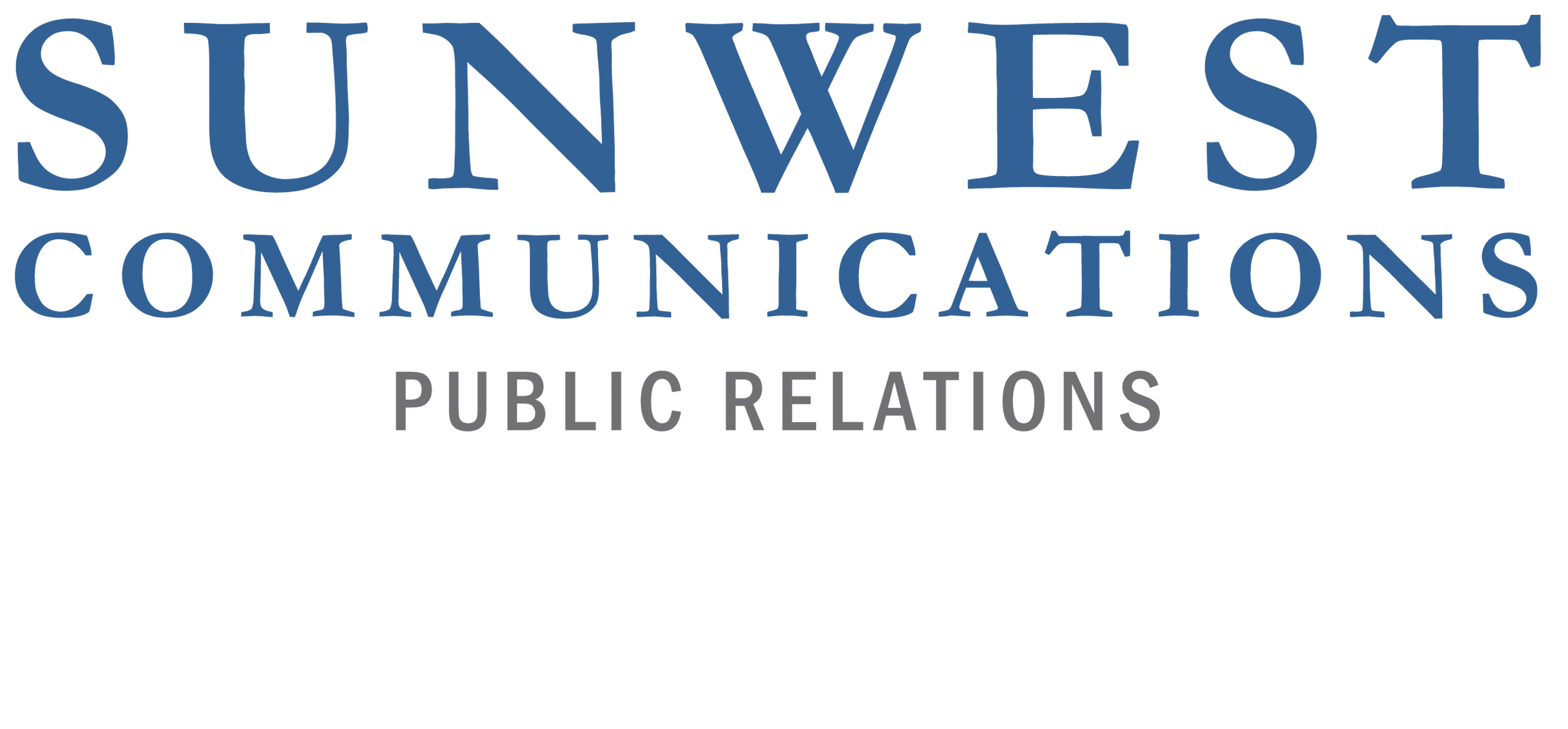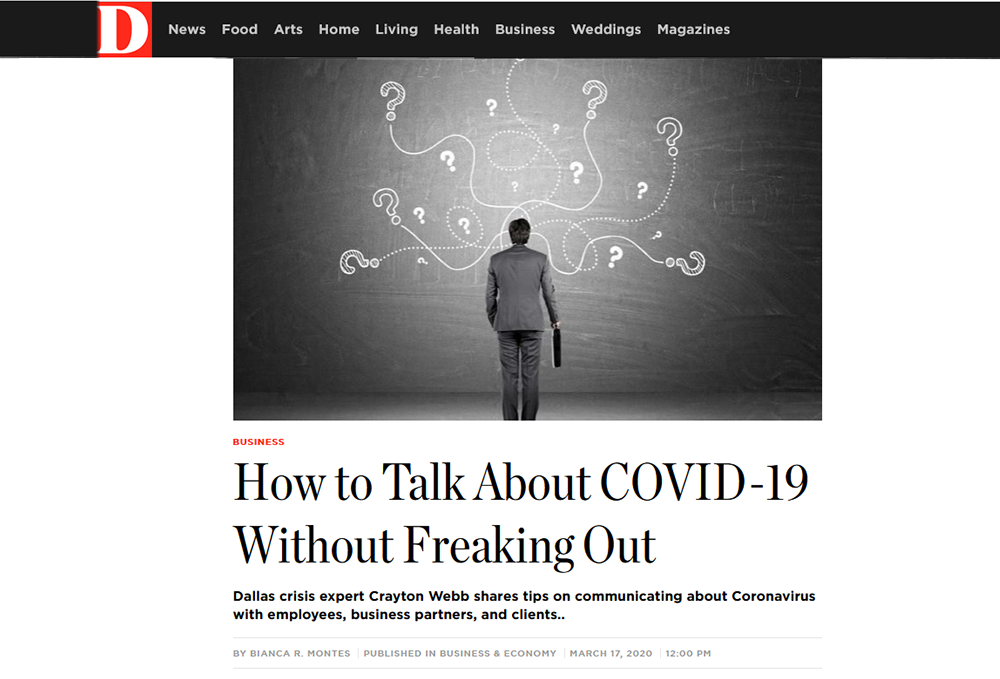News
How to Talk About COVID-19 Without Freaking Out (D Magazine)
March 17, 2020
Dallas crisis expert Crayton Webb shares tips on communicating about Coronavirus with employees, business partners, and clients..
We’ve all received the email; it goes something like: “Dear so and so, our No. 1 priority is the health and wellness of our community, staff, and clients. Given the recent coronavirus developments …”

Recent WHO (World Health Organization) announcement about the pandemic is raising many uncertainties and questions about the way business will now be conducted in Dallas-Forth Worth—and around the world. Reaching out to employees, business partners, and customers in the face of such a crisis is no easy feat. Questions–and doubt–about what to say, what not to say, and how to not freak out when talking about COVID-19 have likely crossed all of our minds.
To help business leaders navigate the situation, we reached out to Dallas communications expert Crayton Webb. The Sunwest Communications CEO has been on the front lines of many crises and has led crisis communications for both a former Dallas mayor at City Hall and a North Texas-based global corporation.
“We see a lot of organizations who want to wait to say anything until they know they have all of the information and know the exact ‘right’ thing to say,” Webb told D CEO. “In a crisis situation, while, of course, getting the facts right is crucial, we also recommend not sacrificing the good for the perfect to communicate to your most important audiences and stakeholders. Those could be your customers, but it most certainly is your employees and perhaps your board of directors.”
D CEO: What are best practices with regard to communicating with employees, business partners, and customers when dealing with an issue like COVID-19?
Webb: First and foremost, it’s important to communicate early and often, even if you don’t have all of the details or don’t necessarily have substantive or numerous updates. The people, including your clients and employees, who trust you with their work and livelihood want to hear from you. Besides, in the absence of any information—even if it’s the same information slightly updated—they will fill the vacuum with rumors and speculation. That can cause fear and even panic.
In times of crisis, it’s critical to reassure your audiences you’re aware of the situation, monitor for updates, and then share any action you would like them to take. It’s always best to begin by reiterating that your first priority is their safety and well-being and that of their family. Of course, your actions need to back-up and support that sentiment.
D CEO: What topics should businesses add to the conversation, and what shouldn’t they address?
Webb: Tough times also challenge our willingness to be open and transparent. The best brands and organizations are willing to share openly what’s working and what’s not and are constantly soliciting for new ideas and solutions. Then, rewarding those suggestions—even if they’re not the right ones for the time—to generate a culture of openness and candor. The best leaders and companies are also willing to admit when they don’t know the answer to a question but commit to finding out or circling back when they do know—and then, of course, doing it. It’s far better to be honest, upfront, and say, “I don’t know” than to speculate and have to recant later. Trust is key.
D CEO: When it comes to a crisis, a lot of communication tends to be reactive. How can companies be more proactive in this conversation?
Webb: Although it’s difficult to think ahead and about what’s around the next corner when you’re head is down during a crisis; we have to. The best brands and organizations were considering and testing their business continuity plans and work from home systems three to four weeks ago. Now, if not very soon, is the time to begin thinking about the aftermath: What will the community, country, and world look like following the crisis? How will your brand survive, rebound, or thrive? Business continuity is one thing, but with the impact on the economy, many businesses will experience devastating impacts. How will your business tell its story when relief to this crisis arrives?
D CEO: What forms of communication seem to work best, and why?
Webb: In times of crisis, like now, it’s best to use multiple forms of communication. People have so much information coming to them so fast. If you want them to pay attention, consider email updates while also planning a weekly or bi-weekly conference call. Make people feel like you’re in touch and in tune with them, even if everyone is working from home or out of the office.
Social media is also a great way to communicate with your customers, investors, and other key stakeholders who have a vested interest in your business. Video is always compelling—as long as it’s short.
D CEO: Where should companies look to stay current on facts?
Webb: Look past those speculating on facts and straight to the source, which in this case is the CDC, WHO, and other local, state, federal, and global organizations.
D CEO: Should companies have a specific plan in place when dealing with the media?
Webb: There should always be a plan for dealing with the media. A crisis is the time to test your media protocol and process. If you don’t have one, get one—ASAP. There should always be a “center of the wheel”—one department or person assigned to working with the media. Everyone should know organization-wide that all media inquiries and outreach should run through that person or team—no exceptions.
It’s critical that your messages to the media align with the messages you’re sending to your most important audiences—your customers, employees, leaders, and board of directors. But the messages also have to be customized for each audience while remaining consistent. It can seem disingenuous if you say the exact same thing with the exact same verbiage to all of your stakeholders. And yet, consistency is key.
When dealing with the media, it’s also imperative to plan the key messages you want to relay. This is your organization’s opportunity to tell your story and put your best foot forward. It takes training and practice to learn how to answer a reporter’s questions thoughtfully while ensuring you’re only sharing the messages you’ve planned and practiced to communicate.

